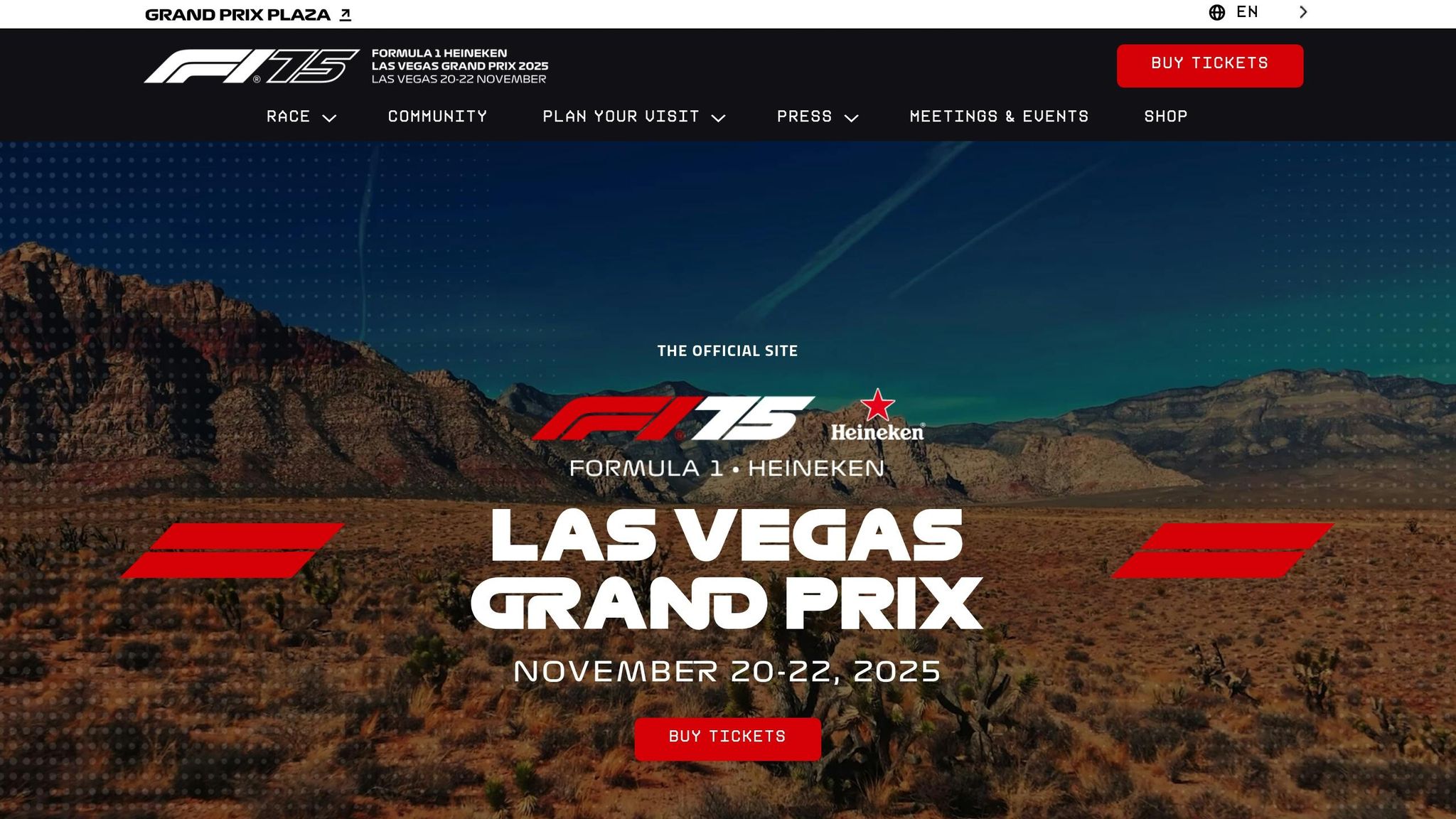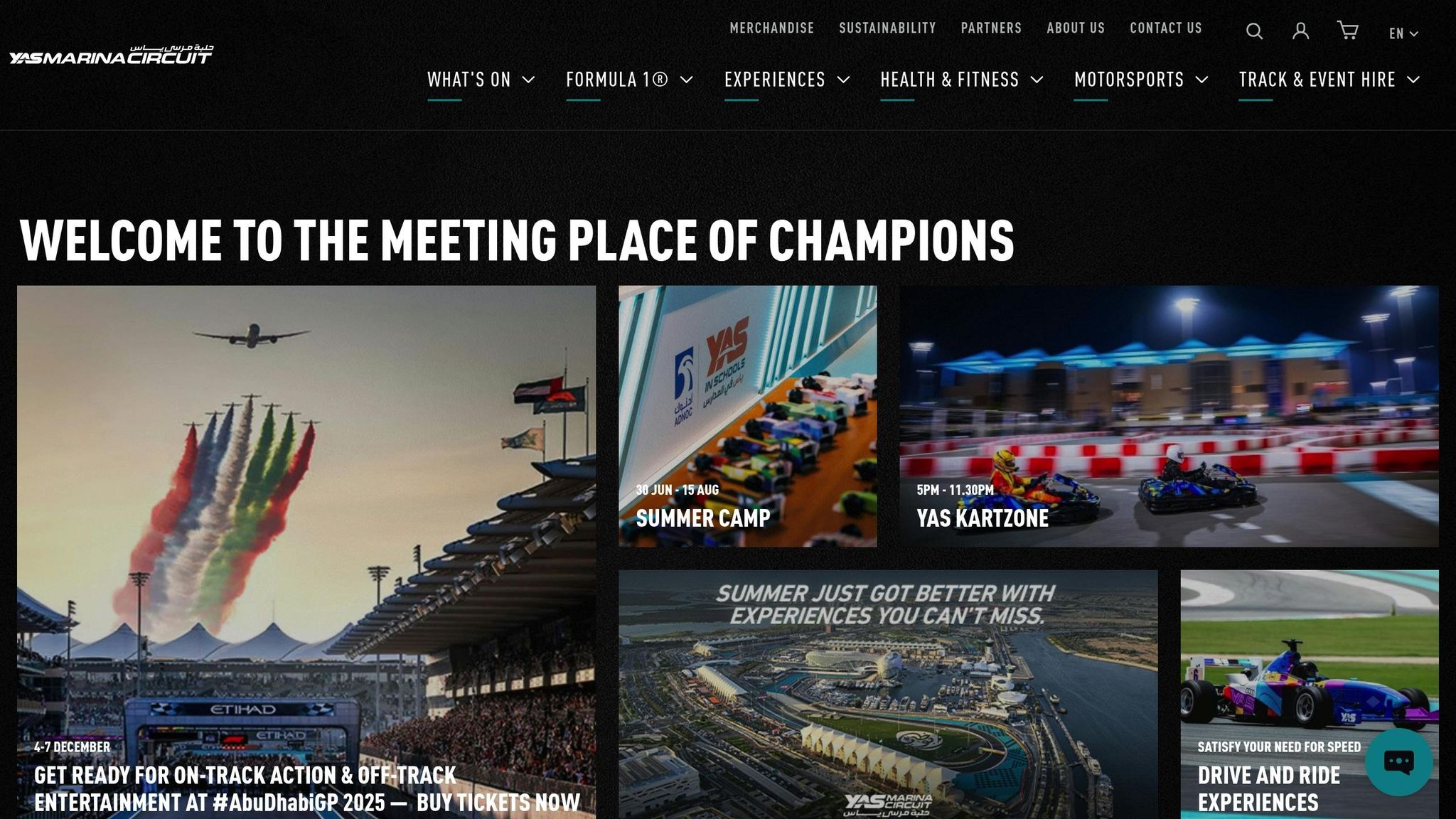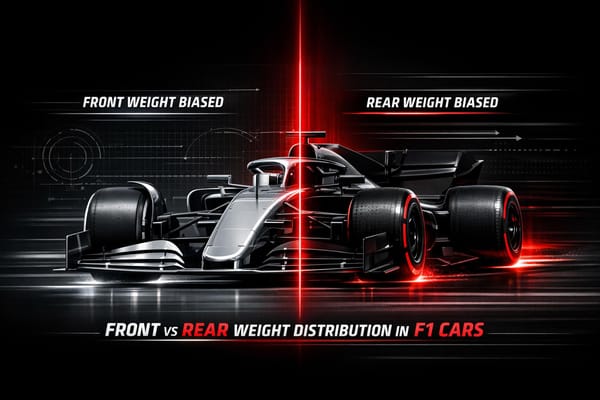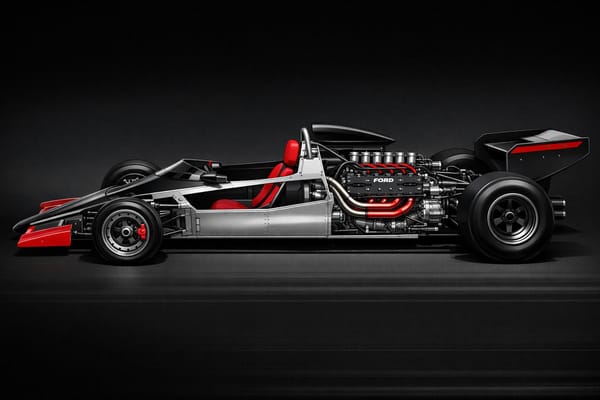Inside Every F1 2025 Circuit: From Monaco’s Streets to Vegas Lights
Explore the unique challenges and strategies of each circuit in the 2025 Formula 1 season, from Monaco's narrow streets to Las Vegas's high-speed layout.

The 2025 Formula 1 season features 24 races across 21 countries, offering a mix of street circuits and permanent tracks, each with unique challenges. From Monaco's tight, historic streets to the high-speed straights of Las Vegas, every track demands careful preparation, precise driving, and tailored car setups. Key factors like track surface, weather, and altitude significantly influence race strategies, while logistical challenges add another layer of complexity for teams.
Key Highlights:
- Monaco Grand Prix: Narrow streets, high downforce setups, and minimal overtaking opportunities make qualifying critical.
- Las Vegas Grand Prix: A modern street circuit with multiple overtaking zones, cooler desert nights, and unique visibility challenges under artificial lights.
- Suzuka (Japan): Famous figure-eight layout with technical corners and unpredictable weather.
- Albert Park (Australia): Semi-permanent track with evolving grip and challenging tire management.
- Yas Marina (UAE): Season finale with long straights, technical sections, and dramatic DRS zones.
Quick Facts:
- Tire Strategy: Varies based on track abrasiveness, temperatures, and Pirelli’s softer compounds for 2025.
- Weather Effects: From desert heat in Bahrain to rain-prone Suzuka, conditions can drastically alter strategies.
- Logistics: Teams transport 50+ tons of equipment across 81,000 miles using air, sea, and biofuel-powered trucks for European races.
Every circuit shapes the season differently, rewarding specific car designs and driver skills. Whether it’s mastering Monaco’s precision or handling Las Vegas’s speed, the 2025 calendar tests every facet of Formula 1.
Ultimate Guide To All F1 2025 Circuits
Every Circuit on the 2025 Calendar
The 2025 Formula 1 season features 24 races across 21 countries, spanning five continents. Each circuit brings its own set of challenges, requiring teams to fine-tune car setups and strategies to match the unique demands of each track. Here’s a closer look at some of the key circuits shaping the championship.
Albert Park Circuit, Australia (March 16)
The season kicks off in Melbourne on a semi-permanent track that combines public roads with purpose-built sections. Spanning 3.3 miles, this circuit features a mix of medium and high-speed corners, making it a critical test for teams to evaluate their off-season development.
Overtaking here is notoriously difficult, so securing a strong qualifying position is crucial. Teams often opt for medium downforce setups to balance cornering grip with straight-line speed. As the weekend progresses, the track surface evolves, gaining grip from rubber laid down during sessions. This makes tire management a key focus. With Pirelli introducing softer compounds for most races in 2025, teams may lean toward two-stop strategies. However, the abrasive surface at Albert Park adds thermal stress to the tires, making it a balancing act between speed and tire longevity.
Monaco Grand Prix, Monaco (May 25)
Monaco’s 2.074-mile circuit remains one of the most iconic and challenging tracks in Formula 1. With its narrow streets and tight barriers, precision is everything, leaving no room for error.
This track demands the highest downforce configuration of the season. Teams sacrifice straight-line speed to maximize grip and stability in the slow, winding corners. Average speeds rarely exceed 100 mph, so aerodynamic efficiency takes a backseat to downforce generation. Brake cooling is another critical factor, given the constant stop-and-go nature of the layout.
Overtaking is nearly impossible, making qualifying performance absolutely vital. Teams often focus on single-lap pace to secure track position, which is key to success in Monaco’s unforgiving environment.
Las Vegas Grand Prix, USA (November 22)

Las Vegas, one of Formula 1's newest additions, offers a thrilling mix of high-speed straights and technical sections over its 3.8-mile layout. Multiple overtaking zones make this circuit a standout, while the late-night 10:00 PM start under artificial lights adds an extra layer of complexity.
Desert conditions mean cooler temperatures at night, which can impact tire behavior and visibility. Track temperatures may vary by as much as 68°F (20°C), forcing teams to adjust strategies on the fly. Cooler conditions can help with tire longevity, but they also make it harder to bring the compounds up to their ideal operating range. Teams typically run lower downforce setups here, prioritizing straight-line speed while maintaining enough grip for the technical sections.
"It's crazy fast, like a street circuit on steroids." – Max Verstappen
Suzuka International Racing Course, Japan (October 12)

Suzuka’s legendary figure-eight design makes it one of the most technically demanding circuits on the calendar. The 3.6-mile track challenges every aspect of car performance, from the high-speed 130R corner to the intricate Spoon Curve and the Esses.
To succeed here, teams need a finely tuned setup that balances high-speed stability with low-speed agility. The variety of corner types forces teams to adopt versatile configurations rather than focusing on a single strength. Elevation changes throughout the track further complicate setup decisions, affecting aerodynamics and suspension.
Weather unpredictability in October adds another layer of strategy. Conditions can shift from sunshine to heavy rain in a matter of hours. Suzuka’s efficient drainage system allows for rapid transitions between wet and dry conditions, creating opportunities for bold tire strategies.
Yas Marina Circuit, UAE Season Finale (December 7)

The season wraps up at Abu Dhabi’s Yas Marina Circuit, a 3.4-mile track that combines long straights with technical sections, providing plenty of overtaking opportunities. The circuit’s multiple DRS zones set the stage for dramatic season-ending battles.
Teams typically opt for medium downforce setups here, balancing the need for speed on the straights with grip in the tighter sections around the marina. Brake cooling is especially important, given the warm December temperatures in the region.
Strategy takes center stage at Yas Marina, especially in a championship-deciding race. Teams rely heavily on data to determine optimal fuel loads, race pace, and tire management. The transition from natural daylight to artificial floodlights adds another layer of complexity, affecting tire temperatures and visibility as the race progresses. This unique environment demands constant adaptability from both drivers and teams.
How Circuits Compare
The 2025 F1 calendar showcases a mix of tracks, spanning tight street circuits and sprawling permanent venues. These variations play a crucial role in shaping team strategies and car setups. Let’s dive into how circuit types, speed profiles, and weather conditions influence race dynamics.
Street Circuits vs. Permanent Tracks
Street circuits and permanent tracks present unique challenges, prompting teams to tailor their setups accordingly. Street circuits prioritize cornering grip, as passing opportunities are scarce. This means maximizing downforce becomes essential. On the other hand, permanent tracks allow for a more balanced approach, enabling teams to optimize for both one-lap qualifying speed and race-day performance.
"I was very quick, but the grid position in our track has become similar to Monaco with how difficult it is to pass." - Carlos Sainz
Even on permanent tracks, overtaking can be a challenge. Suzuka, for instance, features just one DRS zone on the main straight, making passing maneuvers dependent on a significant pace advantage.
"I heard a lot of times that it was a difficult track to overtake. It surprised me, because even with (a) four-tenths pace advantage, it was difficult to overtake." - Gabriel Bortoleto
To address such challenges, governing bodies have introduced changes. For example, the World Motor Sport Council implemented a rule requiring Monaco to have a minimum of two pit stops per race, aiming to enhance overtaking opportunities.
High-Speed Tracks and Overtaking Zones
Beyond circuit type, track speed also plays a pivotal role in shaping overtaking chances and overall race dynamics. High-speed tracks, like Monza, are known for thrilling slipstream battles and heavy braking zones, creating plenty of opportunities for drivers to make bold moves.
| Circuit | Corner Count | Key Characteristic | Overtaking Difficulty |
|---|---|---|---|
| Monza | 11 | Long straights, heavy braking | Easy – multiple opportunities |
| Jeddah | 27 | High-speed street circuit | Moderate – 3 DRS zones |
| Spa-Francorchamps | 19 | Elevation changes, Kemmel Straight | Moderate – weather dependent |
| Marina Bay | 23 | Technical, high humidity | Difficult – tight layout |
| Suzuka | 18 | Flowing esses | Difficult – single DRS zone |
The Jeddah Corniche Circuit stands out with its 27 corners - the most on the F1 calendar - and three DRS zones that make overtaking possible, though still challenging.
"Long, dull, not much happening. I spent all my race in traffic, too, and it's not that fun looking at someone's rear wing and the DRS. It's so difficult with these cars. The dirty air effect, year on year, gets a little bit worse." - Nico Hülkenberg
Weather and Climate Effects
Weather conditions can swing dramatically across race weekends, with temperatures ranging from 41°F to 108.5°F. Desert circuits like Bahrain and Abu Dhabi push drivers to their physical limits, with cockpit temperatures climbing to 140°F. Over a 90-minute race, drivers can lose up to 3kg of bodily fluids.
"When you're driving on a track that's nice and cool, the tires cool down pretty much every time you race down the straight. But on the other hand, when the track is scorching hot, you are basically driving on top of a saucepan, heating up the tires, so they don't afford you as much grip." - George Russell
Rain-prone venues like Suzuka and Spa-Francorchamps add another layer of complexity, as teams must adapt to unpredictable shifts between wet and dry conditions. Spa, with its 102.2m elevation change, often experiences microclimates that can create vastly different conditions across the track. Meanwhile, Monza is projected to see the highest rainfall of any circuit, with an average of 13.34mm.
Wind also plays a role, particularly at exposed circuits, where it can disrupt aerodynamic balance and force teams to make real-time adjustments. The Miami Grand Prix, scheduled in early May to avoid peak hurricane season, still faces the risk of sudden thunderstorms, which can dramatically alter race strategies.
Race Strategy and Technical Setup
Every race circuit presents unique challenges, shaping technical decisions like aerodynamic setups and fuel strategies. Engineers must carefully balance these factors to ensure peak performance during both qualifying sessions and the race itself.
Tire Strategy and Wear Patterns
The track's surface abrasiveness directly impacts tire wear, dictating how aggressively teams can push their tires during a stint. To stay ahead, teams rely on real-time data to monitor tire temperatures, pressures, and wear rates, fine-tuning performance accordingly. Managing tire temperature is particularly crucial - just a 10°C rise in wheel rim temperature can increase the tire carcass temperature by 1°C, altering grip and accelerating wear. Drivers play their part by adjusting brake bias and employing techniques like "lift and coast" to keep tire temperatures in check. Teams also aim for even wear on both axles to maintain consistent performance throughout each stint.
Strategists use advanced analytics and simulations to determine the ideal timing for pit stops. Sometimes, teams gamble on an undercut strategy, sacrificing track position to bring fresh tires up to optimal temperature faster. This delicate dance of tire management often goes hand-in-hand with aerodynamic adjustments tailored to the specific circuit.
Aerodynamics and Car Configuration
Aerodynamic setups are another critical piece of the puzzle. Teams tweak their configurations based on the circuit's demands. For instance, high downforce setups are essential on tight, winding tracks like Monaco to maximize grip in corners. Meanwhile, circuits with long straights favor low-drag setups to boost top speed. These adjustments aim to find the perfect balance between qualifying speed and race-day efficiency.
Fuel and Brake Management
Fuel and brake management also play a pivotal role in race strategy. Tracks with extended high-speed sections require heavier fuel loads, which can slow cars down early in the race. On the other hand, technical circuits with frequent heavy braking demand careful brake management to handle the thermal stress. Teams must also adapt their strategies during race interruptions, like Safety Car periods, to optimize fuel usage, extend stints, and adjust pit stop timing effectively.
Logistics and Operations
Transporting Formula 1 across the globe is no small feat - it’s a logistical operation on par with military precision. Each team moves the equivalent weight of eight elephants per race, shipping about 50 tons of cargo annually, with costs exceeding $8 million. On a larger scale, DHL, Formula 1's official logistics partner, covers more than 81,000 miles per season, relying on six to seven Boeing 747 cargo planes per event. These numbers highlight the immense effort required to manage logistics for races in vastly different environments.
Long-Distance Race Transport
With 24 Grands Prix spanning five continents in the 2025 season, the logistical demands are staggering. Each team transports six chassis (two per driver, plus a spare) along with 40–50 tons of spare parts, data servers, and pit-wall electronics. For context, in 2021, DHL moved 1,540 tons of equipment and 532 cars over 74,500 miles.
Teams organize their cargo into three categories:
- Critical loads: Transported via air charter, these include chassis, power units, and control electronics - essential components for assembling cars immediately upon arrival.
- Priority items: Shipped by air or express sea freight, this category includes garage IT racks and pit-wall equipment crucial for data and communication systems.
- Bulk cargo: Moved via sea freight, this includes hospitality equipment and non-essential spares, offering a cost-effective and lower-emission option.
"The schedules are so tight, this industry and what we're working in now, everything is pushing the boundaries of what's possible - and that also extends to logistics."
– Simon Price, Event Manager for DHL Motorsport
The pressure is relentless. Teams ship 660 tons of air freight and 500 tons of sea freight in a single season, with up to 300 trucks transporting equipment between European races. To mitigate risks like delays, teams prepare backup routes, duplicate critical parts, and plan for remote assembly if necessary.
In 2023, DHL introduced biofuel-powered trucks for European events, cutting carbon emissions by an average of 83%. These trucks traveled over 6,600 miles across nine races, carrying an average of 300 tons of freight per event. Such advancements add another layer of complexity to the already challenging logistics of street circuits.
Street Circuit Setup
Street circuits like Monaco and Las Vegas introduce logistical hurdles that permanent tracks don’t. Unlike facilities like Silverstone or Monza, which have established infrastructure, temporary circuits require teams to build everything from scratch - and they only have 72 hours to do it. This tight timeline, set by the FIA, adds a layer of urgency to an already high-pressure environment.
Space constraints at Monaco highlight these challenges. Teams stack hospitality suites on top of each other, resembling LEGO blocks, to make the most of the limited area. Meanwhile, Las Vegas took logistical complexity to a new level. Constructing the 800-foot-long Flamingo Road bridge required eight days for assembly and disassembly. The city also replaced up to 10 inches of road with denser pavement to handle F1 cars, while installing three temporary bridges to maintain access to hotels.
"There are other street races on our calendar, such as Monaco and Singapore, but even when you consider those, this is a living, breathing city, that's 24 hours, nonstop action. To bring an event of this magnitude and shut down the roadways at the same time; there's just no playbook for this."
– Renee Wilm, CEO of Las Vegas Grand Prix
The challenges don’t stop at setup. Streets must reopen to traffic after each session, requiring constant setup and teardown cycles that wouldn’t be needed at permanent tracks. Additionally, street surfaces often have variable grip due to public road markings and mixed asphalt types, forcing teams to adjust car setups on the fly. During the 2023 Las Vegas Grand Prix, logistics delays caused some teams to scramble, leading to last-minute calibration issues.
Local Culture and Fan Experience
The challenges of Formula 1 logistics extend beyond moving equipment. Teams must also adapt to local time zones, climates, and conditions to ensure peak performance. In the 2024 season, teams faced a grueling 8,200-mile journey on a 19-hour flight with less than a week to adjust to a 12-hour time difference before the season finale. Over nine months, drivers visited 20 countries, requiring constant adaptation.
To combat these challenges, teams now work with sleep specialists to manage drivers' circadian rhythms. Light exposure plays a key role, with teams using strategic lighting and light-blocking sunglasses to help drivers adjust. Performance coaches also recommend extra sleep in the first few days after travel to help the body adapt.
"F1 drivers have had to become masters in adapting to different time zones in extremely short periods of time. It's a global sport that often takes them to several countries (even continents) in a week."
– Simon Mawdsley, Co-Founder of Grand Prix Grand Tours
Las Vegas, in particular, poses extreme challenges. Tom Clark, senior performance coach with Alpine F1 Team, described it as “the nastiest one of the season”. Teams use everything from electronic devices to natural light to shift drivers’ internal clocks closer to local time zones.
Even small details, like hotel noise levels and room lighting, play a significant role in recovery. Teams monitor biometric data to spot early signs of fatigue and adjust hydration strategies for hotter climates days in advance.
McLaren exemplifies the modern, data-driven approach to global operations, collecting terabytes of data from their race cars and nearly 1.5 terabytes of content per race weekend through video and social media efforts. This data not only enhances driver performance but also shapes fan engagement strategies tailored to each location.
"You're only going to find those tenths of seconds by really searching through the data."
– Ed Green, Head of Commercial Technology at McLaren Racing
Conclusion: Circuit Impact on F1 Racing
The 2025 Formula 1 season highlights how the characteristics of each circuit shape every strategic choice and performance outcome throughout the championship. As Red Bull's Adrian Newey aptly points out:
"Fundamentally, I think the circuits are probably the biggest influence [on the outcome of a race]. Everybody keeps conveniently forgetting about that, as it is deemed to be easier to change the cars than change the circuits".
Track design plays a pivotal role in determining team priorities. For instance, circuits like Hungary and Singapore reward cars with exceptional cornering speed, while power-heavy tracks like Monza favor straight-line performance . These differences are at the heart of how teams develop and adapt their strategies over the course of the season.
Each venue also brings its own physical challenges, adding another layer to race strategy. Singapore, for example, tests drivers with intense heat that can lead to a 6.6-pound weight loss during the race, while Silverstone demands sharp mental focus, with drivers averaging speeds of 152 mph . These physical factors often force teams to make tough compromises in their planning.
Overtaking opportunities further influence how teams approach each race. Bahrain's layout encourages thrilling wheel-to-wheel battles, while Monaco's narrow streets limit overtaking, pushing teams to focus heavily on qualifying performance instead of race pace.
Understanding these circuit-specific nuances is key to appreciating Formula 1's complexity. Take Max Verstappen’s dominant performance at the rain-soaked 2022 Japanese Grand Prix as an example. His win was a result of years of wet-weather practice combined with Red Bull's setup designed specifically for Suzuka. As Verstappen himself explains:
"Growing up in Belgium and Holland, it rains a lot. So, we never like turned around when it suddenly started raining. We would put the rain tires on and we would go and practice and that just helps a lot. You get a lot more understanding of what you have to do when it rains."
This constant balancing act is why no single team can dominate every race. Tracks like Baku present unique challenges, requiring teams to generate enough downforce for the corners while minimizing drag for the long straights. These technological trade-offs push teams to continuously refine their strategies as the season progresses.
For 2025, the diversity of circuits ensures a competitive balance across the 24-race calendar. With a mix of street circuits, permanent tracks, and varied weather conditions, the season offers opportunities for different teams and drivers to shine. Each circuit’s distinct challenges reaffirm why Formula 1 remains the ultimate test of both human skill and engineering precision.
FAQs
How do F1 teams handle changing weather conditions during the 2025 season?
F1 teams depend heavily on cutting-edge weather forecasting tools and real-time data streams to navigate unpredictable weather during races. These tools help them make split-second decisions about tire choices, pit stop strategies, and car setups, all tailored to the track's current and expected climate.
To keep performance at its peak, teams fine-tune critical factors like aerodynamics and tire pressures based on conditions such as rain, extreme heat, or chilly temperatures. With constant monitoring and advanced prediction software, they can respond instantly to sudden weather shifts, ensuring they remain competitive regardless of what the skies bring.
What challenges do F1 teams face when transporting equipment during the 2025 season, and how do they overcome them?
The Logistical Maze of F1: Moving 50 Tons Across Continents
F1 teams face a monumental task every season - transporting nearly 50 tons of gear per team across the globe. This includes not just the cars but also spare parts and the infrastructure needed to keep operations running smoothly. With the 2025 season spanning multiple continents, teams must juggle speed, safety, and cost to make it all work.
To meet these demands, teams use a combination of air, sea, and road freight. High-priority items like cars and critical components are flown via dedicated jets to ensure they arrive quickly. Meanwhile, larger, less time-sensitive gear travels by sea, keeping costs in check. To protect their equipment, teams rely on custom-built crates and climate-controlled vehicles, safeguarding sensitive materials from damage. This meticulous planning helps them sidestep potential disruptions - whether from weather, geopolitical hurdles, or mechanical issues - so they’re ready to hit the track at every race.
How do new circuits like Las Vegas influence F1 team strategies and car setups in 2025?
The Las Vegas Grand Prix brings a fresh challenge to the table with its combination of long straights and tight corners. Teams are pushed to fine-tune their aerodynamic setups to strike the perfect balance between achieving high top speeds and maintaining stability during intense braking zones. With speeds soaring up to 215 mph on certain sections, managing tire pressures and brake balance becomes absolutely crucial to control wear and sustain performance throughout the race.
These unique track demands compel teams to meticulously adjust their car setups and rethink their race strategies. The goal? To master the circuit’s mix of speed, precision, and technical demands. This dynamic balancing act of raw power and control cements Las Vegas as an exciting and challenging addition to the 2025 racing calendar.




